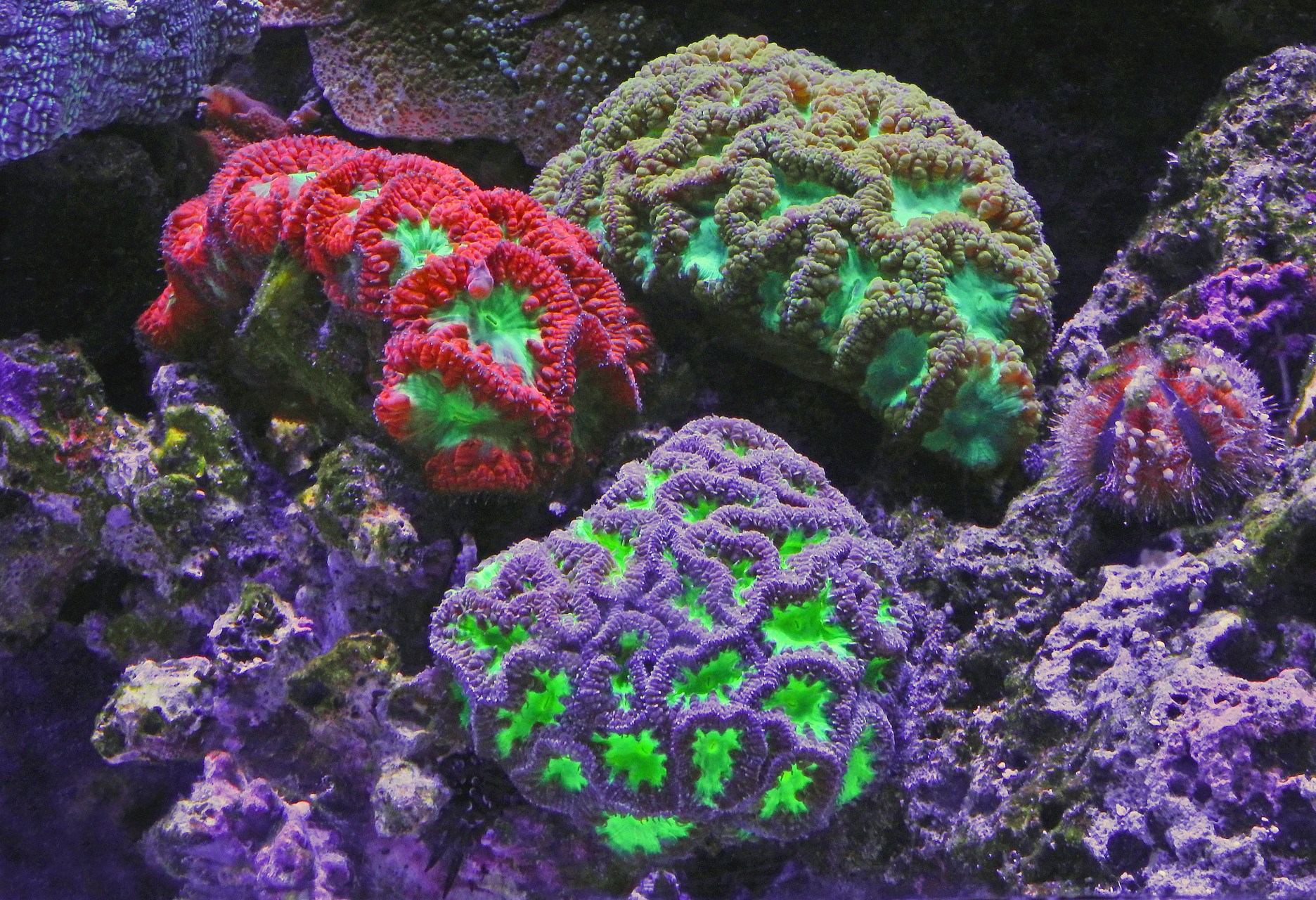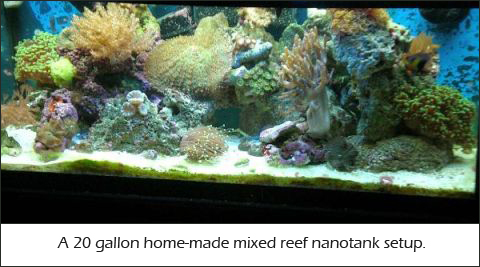Nanoreef Aquariums Revisited


Introduction
To the casual observer, few aquaria are as impressive looking as a large reef tank. However, experienced aquarists know that the most challenging reef tanks to maintain are actually ones which are very small. Commonly known as nanoreef and picoreef systems, they can come in sizes as small as one gallon, but typically vary between 5 and 35 gallons. The size and simplicity of a nano will enhance your skill as a reef-keeper. Whats more, a surprising number of elegant design possibilities result from the inherent limits of the system. A nano can be anything from an artistic showcase for a delicate gorgonian to a miniature biotope complete with fish, coral, sponges, and all other manner of critters. This article covers some of the dos and donts of keeping these tiny reef tanks.
Naturally, the diminutive size creates a unique set of challenges which must be overcome. Some older husbandry books recommend against keeping nanoreefs but advances within the trade have now made it more than feasible to have success on such a small scale. More varieties of small, hardy species are available now than ever before. Moreover, buffers and micronutrient solutions have been tailored for nanos to minimize the chance of overdoses. In fact, there has been a marked increase in the number of nano/pico options available in recent years. Many small aquariums are now presented with fully integrated saltwater components, including lights, pumps, sumps, and even protein skimmers. By keeping things small, nanoreefs are simply much more affordable than their larger counterparts. Technological and academic advances in marine husbandry at the nanoreef level are helping to open up the world of the saltwater aquarium to a much wider audience.
The challenges of maintaining such a small system are easily offset by the cost-effectiveness and the personal reward of honing your craft to an advanced level. Keeping a nano/pico will surely make you a better aquarist as you will need to be well-informed, diligent, and attentive to the system. However, if you are currently keeping a successful saltwater tank, you probably already have good husbandry practices. If you are new to saltwater, then a nanotank will test you, but you will need to develop those good habits sooner or later. While it is not ideal for reef initiates to start this small, it is possible and may be worth it when considerations for cost and space are inputted.
There are two basic facets of nanoreefs that make them more challenging than larger systems. First, the small water volume can lead to rapid changes in chemistry and water quality. Simply stated, it takes far less of a given chemical to pollute the system. Second, the space limitations necessitate very thoughtful selection and placement of livestock. Care must be taken in order to choose non-stinging corals (unless for specimen tanks) and livestock which will not grow too large.

Water Chemistry
The inherently unstable nature of a small water volume can quickly lead to poor water quality due to overfeeding, excessive dosing, and rapid evaporation. The route to overcoming some of these problems generally requires a minimalistic approach to stocking. It is a good idea to limit livestock to a small number of coral and/or fish. Maintaining a low bioload is essential in a nanoreef tank. Feeding should be done no more than once a day and the only what they eat in two minutes rule of thumb must be strictly observed. You will also benefit from using nanoreef-specific additives. These solutions are specially formulated to allow easy and accurate dosing on a small scale.
Choosing a good location for your nanoreef tank will also help to ensure success. The temperature of the water will fluctuate more quickly and extremely than it would in a big tank. It is especially important to keep your nanoreef out of direct sunlight, and away from drafty doorways and heater vents. Also, consider the lighting you will be using. All light sources create some degree of heat so it is wise to run the lighting for several full cycles before adding livestock. This method will allow you to log temperature changes and adjust the lights distance and ventilation without subjecting any animals to harm. Good temperature control is also a key to good evaporation control. As evaporation rates will vary according to many factors, it is impossible to predict how much water will be lost from a given nanoreef system. However, minimizing temperature fluctuations will generally lead to consistent evaporation rates. Being able to predict how much RO/DI water you will need to replenish daily will help you know how much you need store.
Choosing Livestock
There are actually many great nano-tank livestock options available today. In fact, most invertebrate livestock and many fish species in the trade can be kept in nanoreefs. The trick is to choose which animal(s) you want to feature, and form the remainder of the system around them. Of course, some very sensitive animals like Flower Pot corals (Goniopora and Alveopora spp.) and seahorses are not likely to do well. Others, like large fish or anemones are simply too big for nano-tanks. It is also important to limit the number of fish in the system. It is difficult to make a generalization about the maximum number of fish to keep, but my own experience has led me to set a restriction of about 1.5 inches per five gallons of water. When in doubt, less fish is better. A dead fish can severely pollute a nanotank with exceptional quickness. So too can nudibranchs, so beware of using sea hares, lettuce nudibranchs, or similar mollusks in your cleaner up crew.
However, aside from the few major restrictions, nano systems are surprisingly versatile. When selecting livestock, you will need to determine how much space you have available and what type of tank you would like to create. A mixed reef, for instance, is best limited to zoanthids, soft corals, and LPS corals (if enough space is provided). SPS corals are best kept in species tanks, or at least with other SPS corals. The small space in a nanoreef makes allelopathy (chemical warfare) a critical factor to keep in mind. For example, zoanthids release palytoxins that are highly toxic to other tank inhabitants (and people too!). Soft corals also conduct allelopathy that can be toxic to other invertebrates. Zoanthids and soft corals are still good choices for the nanoreef environment, but both should be kept in a system using a nano-skimmer coupled with moderate water flow. In the past, I have kept a large variety of animals in nano-reefs as small as 5 gallons. My livestock choices have include numerous zoanthid species, mushroom polyps, Frogspawn and Torch corals, digitate finger leathers, toadstool leathers, sponges, and kenya tree corals. I also suggest small fish species such as blue chromis, pajama cardinals, pygmy angelfish, flame hawkfish, and gobies. Larger fish or those with voracious appetites (e.g. mandarin gobies) are inadvisable.
If a specimen tank is what you are after, then your main coral or sponge will obviously be the spotlight animal, and thus the focal point. Any other animals will probably be limited to the clean-up crew and maybe some colorful polyps or sponges used to add contrast. Specimen systems are really my favorite type of nano-tank. Done well, they can be almost like a painting. Imagine a solitary chunk of coralline covered live rock, sunk in some clean white aragonite sand. Add a bright red gorgonian emerging from a field of metallic blue daisy polyps, a purple and yellow pygmy angelfish, and quality lightingvoilayour very own masterpiece.
Closing Arguments
In the end, is it worth a foray into nano-tank care? In my mind, the answer is unquestionably yes. Nano-tanks will impress your friends. They can fit on your desk at work. They give you the chance to own a pretty little fish that would not stand a chance in a big tank with big fish. They will not devastate your bank account, nor will they occupy all your time. Are they harder? Yes. However, they are not so much more difficult as to be impossible. In fact, they are much easier to care for than commonly perceived. Todays technology has advanced aquarium husbandry to such a finely-tuned degree that virtually nothing is impossible anymore. For a beginner, a nano-tank might be too much. On the other hand, it might be the catalyst for a great career in reef-keeping. A successful nano-tank is a successful tank indeed. At the same time, a nano-failure is less costly than a failure in a large tank. You lose less livestock and live rock, and the repair process is less severe. Now, with all the exceptional equipment options, along with comprehensive nano-tank packages, the nano is more achievable than ever before.
Works Cited:
Brightwell, C.R.The Nanoreef Handbook Neptune City: T.F.H Publications, 2006.
Goldstein, Robert J. Marine Reef Aquarium Handbook Hauppauge: Barrons, 1997.
Jennings, Greg. The New Encyclopedia of the Saltwater Aquarium. Buffalo : Firefly books Ltd., 2007.
Shimek, Ronald L. Marine Invertebrates. Neptune City: T.F.H Publications, 2004.
Tullock, John H. Natural Reef Aquariums; Simplified Approaches to Creating Living Saltwater Microcosms Neptune City: T.F.H Publications, 2001.